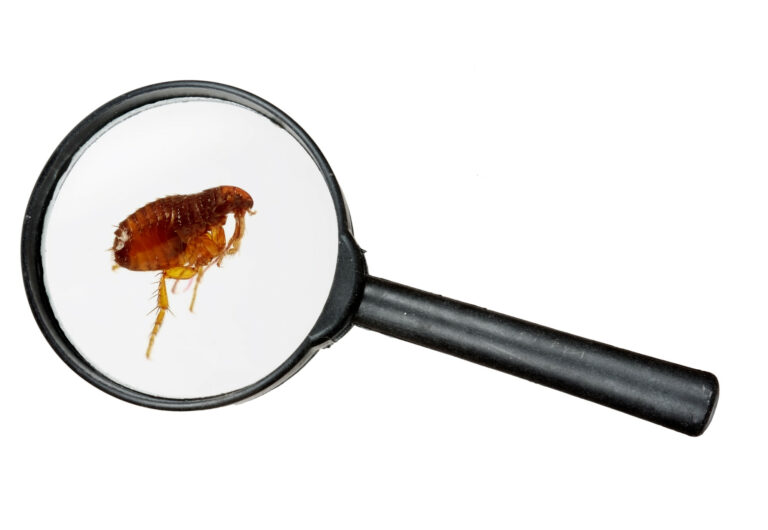5 Signs of Fleas in Your Home
Published: July 3, 2023

An adult female flea can lay up to 40 eggs a day! This adds up to over 1000 eggs in a single lifespan. While this is a staggering number, what makes it worse is that there probably isn’t just one female flea at a time.
This is why it’s so important that you can spot the signs of fleas in your home. Not only do these pests cause severe itching for pets and humans alike, but they can also carry disease. If you can spot a flea infestation before it becomes severe, you can get rid of the problem much easier.
Keep reading to find out more about the common signs of fleas in your home.
1. Itchy Pets
If you’re part of the 67% of American households that own at least one pet, you know how important it is to routinely check your pets for fleas. Unlike humans, your pets can’t tell you if they’re itching or uncomfortable, so you have to make sure they aren’t invested, especially since domestic pets are fleas’ favorite hosts.
You don’t have to constantly check your pet’s fur; simply take note of how often they’re scratching themselves. Some scratching is normal, but you might have a problem if it becomes excessive.
Unfortunately, excessive scratching can also be caused by other issues like dry skin, so you’ll need to manually check their skin if you suspect they might have fleas. Most often, fleas will cling to areas your pets can’t easily scratch. Take extra care when checking the back of their head and neck, as this is a prime hiding spot for fleas.
If your pet has a thicker coat, it can be harder to see their skin. Thicker coats also offer fleas more places to hide, as your pet can’t easily scratch through the layer of fur.
Take extra care during flea season. Depending on your area, flea season runs throughout spring and summer, but if you’re in a warmer area, they can be found year-round.
2. Irritated Skin
If you have house pests, chances are you’ll quickly start to notice small red bumps on your skin. They might not itch, but your skin will be irritated and red.
Unlike with pets, you can’t just check your skin to see if fleas cling to you. But if the infestation is extreme, this can definitely happen!
If you notice irritated skin and have a pet, start by checking if they have fleas before making any decisions. It might just be that you have an allergic reaction to something.
If you or your pet have allergic reactions to the fleas themselves, then the irritation will be more severe. Instead of small red bumps, you might notice red welts, sores, and large patches of irritation.
Even if you get rid of the flea infestation, it’s best to see a doctor for your allergic reaction and to schedule a visit with your vet to get your furry friend checked out.
3. White Sock Test
The white sock test is one of the best ways to determine if you have a flea infestation. Bites and scratching aren’t always something you notice immediately, so you need a different way to ensure your home is pest free.
Simply put on a pair of white socks and walk around your home. Consider wearing longer socks that cover your ankles to prevent flea bites. If you haven’t been bitten yet, you don’t want to start now.
While you’re walking around, focus on carpeted areas, as fleas are more likely to cling to your socks when you disturb their hiding spot. After a few minutes, carefully remove your socks and inspect them to see if any fleas are present.
If you spot a flea, you need to act quickly. If you haven’t been bitten yet, chances are the infestation is in the beginning stages, so if you contact pest control services, they can get it sorted quickly.
4. Flea Dirt
Flea dirt is another way to spot fleas before you start experiencing itching. While it might just be normal dirt and dust, if you see red-brown or black specks around your home, there’s a possibility that it’s caused by fleas.
Flea dirt is actually feces, and the color comes from digested blood. To check if it’s actually flea dirt, collect the specks on a white paper towel and spray it with water. If the paper towel takes on a reddish-brown hue, then it’s most likely flea dirt.
5. Pale Gums
Fleas feast on your and your pet’s blood. This can cause anemia if it goes on for a prolonged period of time, as you have a reduced amount of red blood cells in your bloodstream. This can make you extremely tired and lightheaded at times.
Check your gums to make sure they’re still a healthy color. If you have pets, it’s a good idea to check their gums as well, as they can also become anemic due to flea bites.
Know the Signs of Fleas
Knowing the signs of fleas can help you stop the infestation before it becomes too severe. No one wants to deal with house pests, so it’s a good idea to contact pest control as soon s possible. Getting rid of fleas is luckily not the most complicated task, so you should be able to be flea free in no time.
If you suspect you might have fleas in your home, contact us today. All U Need Pest Control has provided family- and pet-friendly pest control services in the Florida area since 2003.